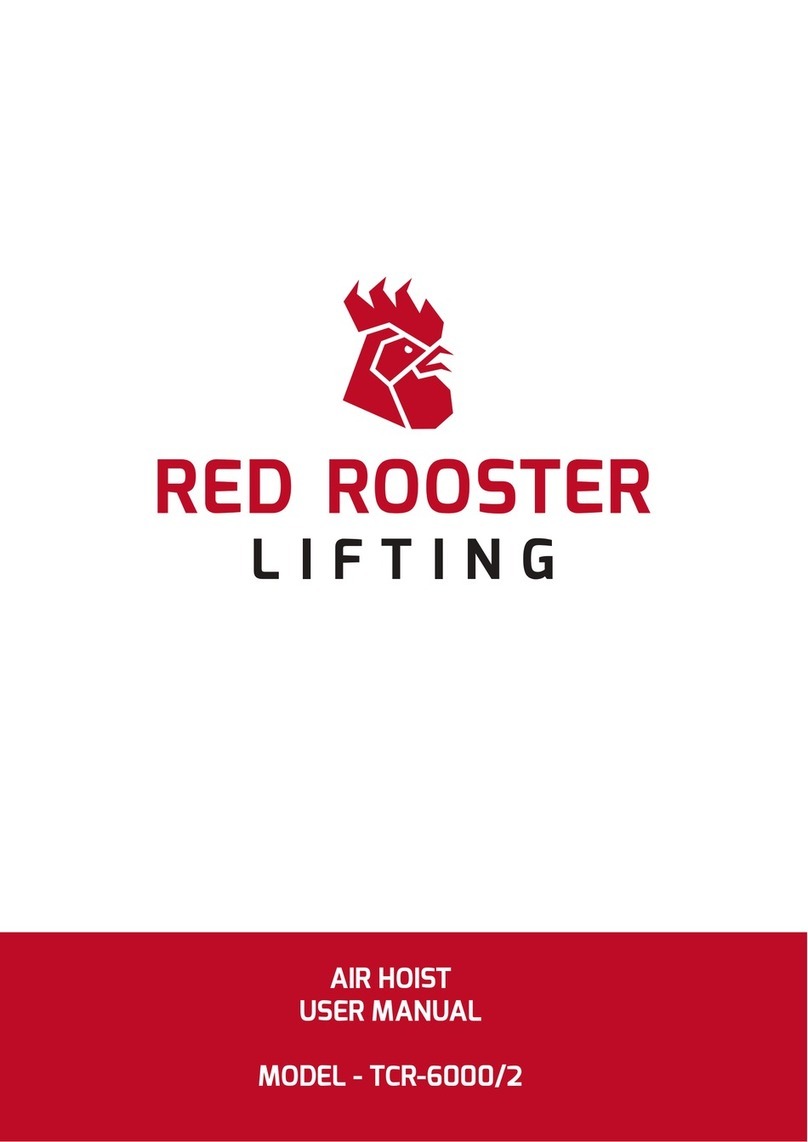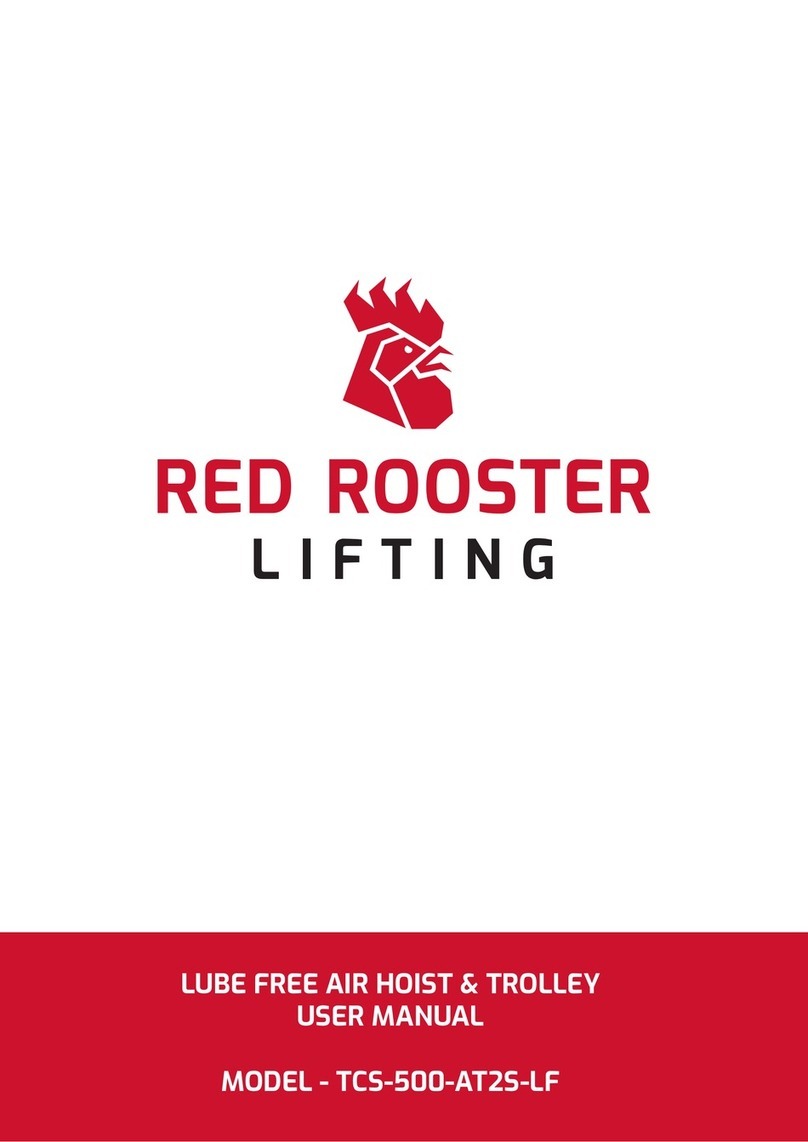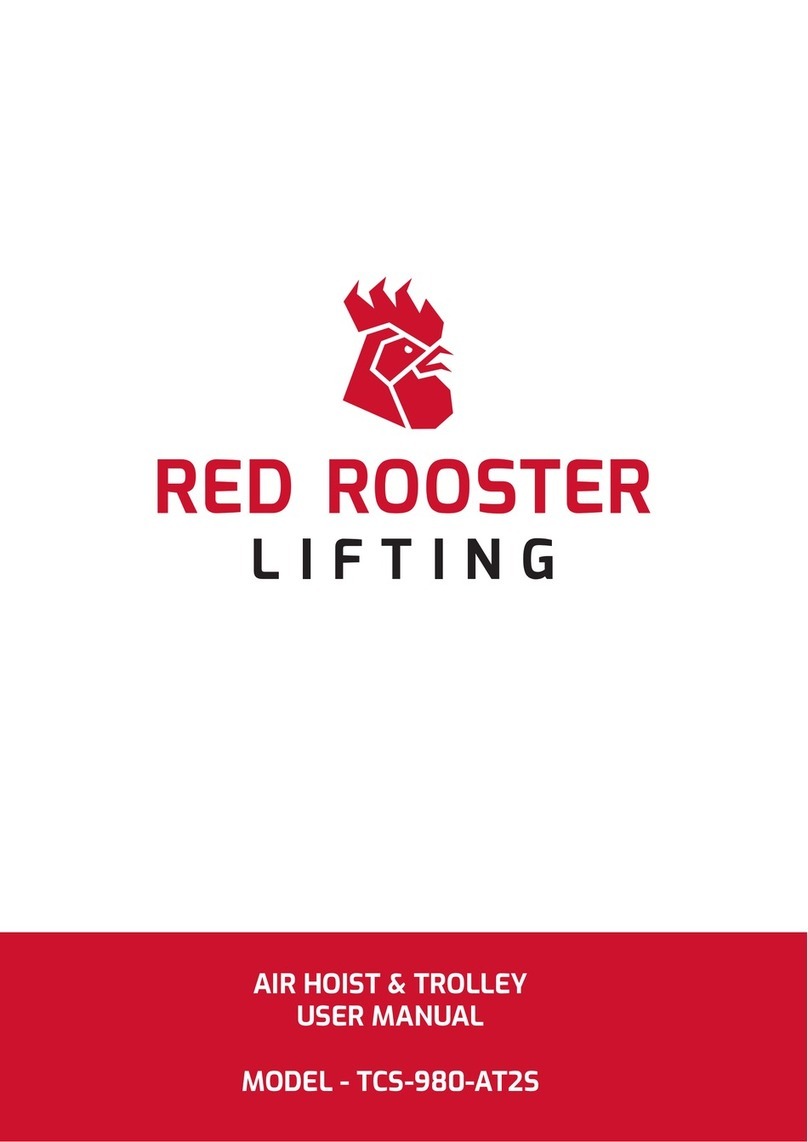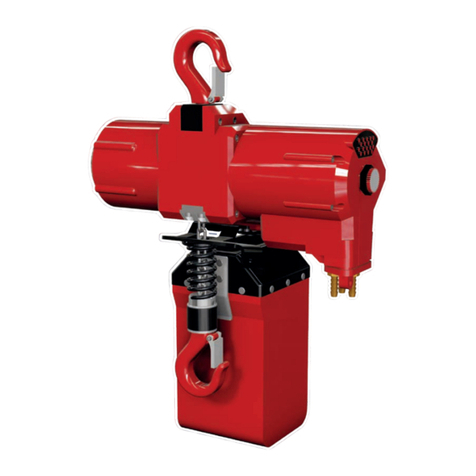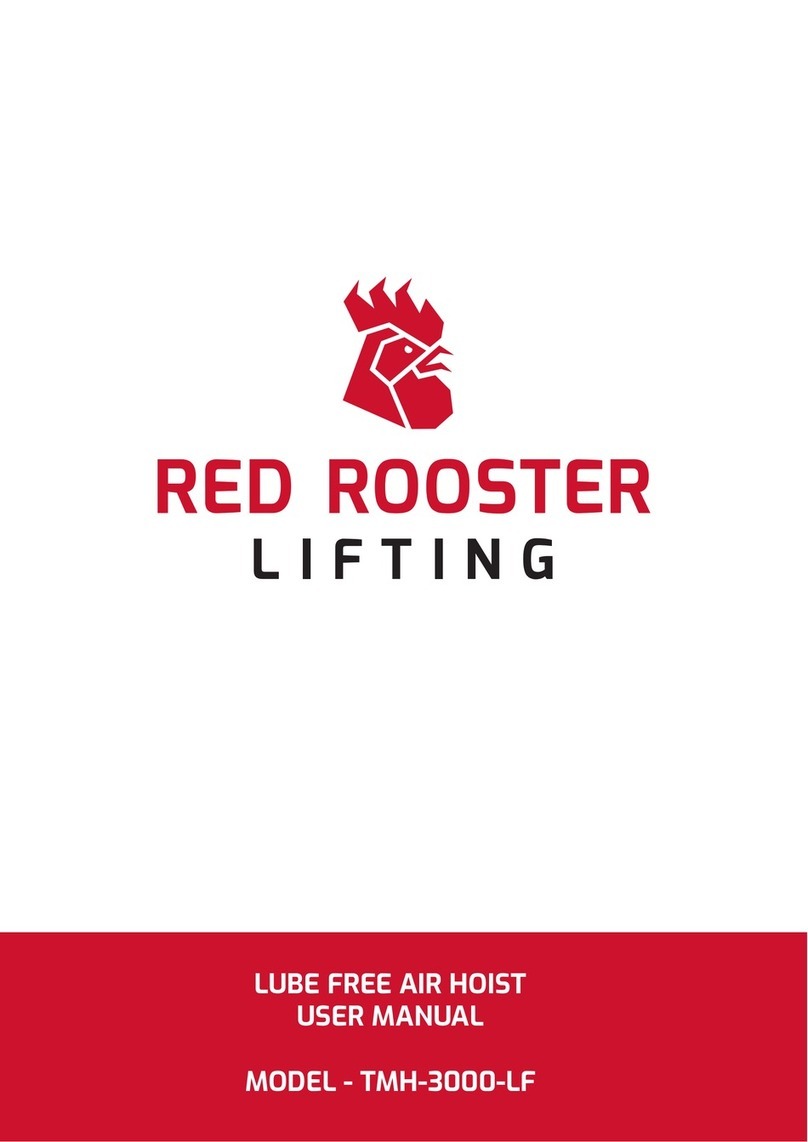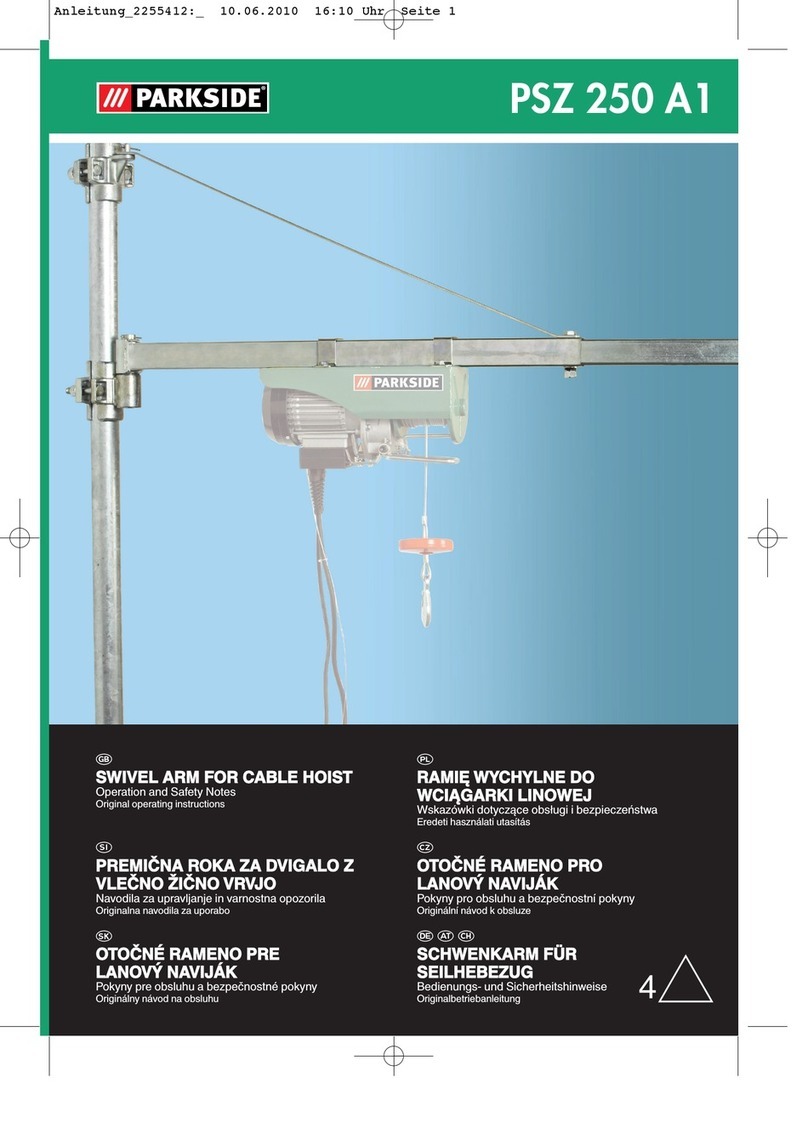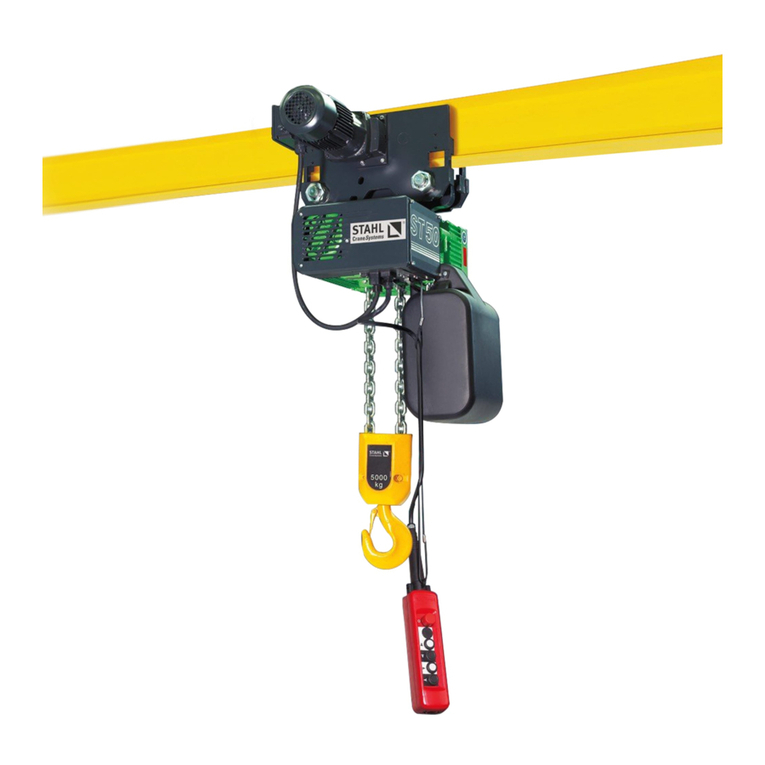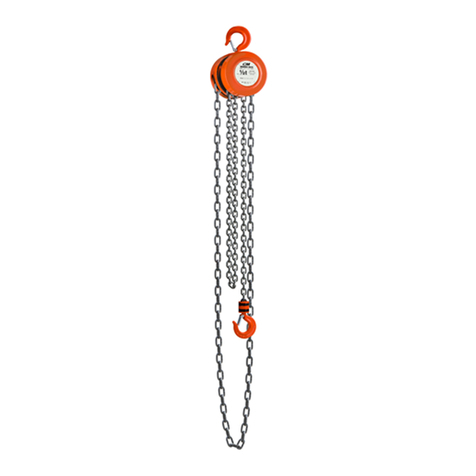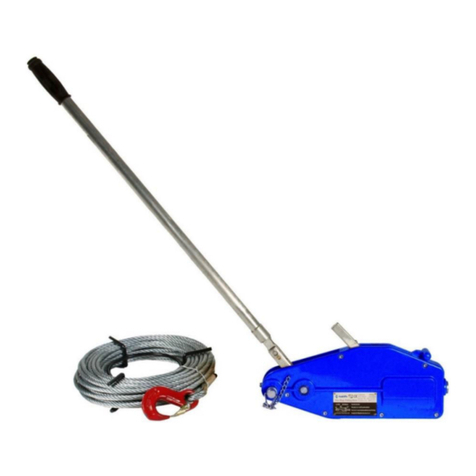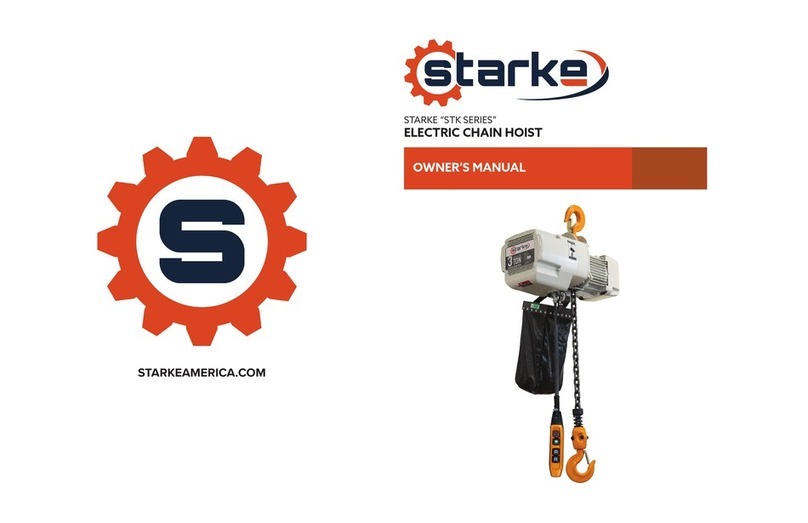
7
USER MANUAL
▪ Red Rooster Lifting Limited ▪Nauta House, The Meadows, Oldmeldrum, Aberdeenshire, AB51 0EZ ▪Tel: +44 (0) 1651 872101 ▪
M01-AH12-AT REV1
GETTING STARTED - CHECKS BEFORE USE & HOSE SUPPORT BRACKET
1.3 CHECKS BEFORE USE
These checks should be carried out during installation and on a frequent and regular basis thereafter. If the hoist is used daily then it is
recommendedthattheyarecarriedoutdailyasthecheckstakeonlyminutestocompleteandnotonlyhelpavoidrepairbillsbutsignicantly
reduce the possibility of an accident or dangerous occurrence. Thoroughly examine the equipment prior to installation to ensure that no
damage has occurred during transit. Hoists and trolleys should not be altered in any way without contacting Red Rooster for clearance, as this
mayaectthecerticationoftheunit.
AIR SUPPLY CHECKS:
▪ Inletpressure:4to6bar(therewillbepressurelossesacrosstheairsetandonlonghoses)Thesupplypressureshouldnot
exceed7barasthismayaecttheloadlimiter.
▪ Airow:Checkairowrequirementandminimumhosediameteralsocheckthatsmallborettingsarenotstranglingtheairow.
▪ Keepthelubricatortoppedupwithalightturbineoil(ISOVG3256).
▪ Theltershouldbecheckedregularlyandmanualunitsdrainedofwaterasrequired.
▪THE AIR HOSE SHOULD BE SUPPORTED SO THAT THE WEIGHT OF HOSE IS NOT HANGING FROM THE AIR SET AND
FITTINGS. THE AIR SET IS NOT DESIGNED TO SUPPORT THE WEIGHT OF THE HOSE. SEE PAGES 7 AND 12 IF A HOSE
SUPPORT BRACKET AND MANIFOLD IS FITTED TO THE HOIST.
▪ Theairsupplyshouldbecleanandrelativelydry.Wherethecompressorproducesalotofwateractionshouldbetakentoremove
the excess water.
▪ Checkairconnectionsizeandtypearecompatible.
▪ Checksecurityofairhoseconnection.
AIR SUPPLY CONNECTION:
Everyinstallationisdierent,sothecorrectmethodofsupportingtheairhoseshouldbereviewedwhileinstallingthehoist.Thisneedsto
take into account the weight and size of the hose, obstructions both at deck and hoist level, connections, operating conditions and any likely
movement of the hoist and air hose.
Thettingsandlterlubricatorarenotdesignedtotaketheweightofthehose.
If the air supply hose length is over 10 metres the hose ID should be increased to the next size.
AIR SUPPLY:
Vane type air motors are designed to function using clean, dry, lubricated air. The installation of an ‘in line’ air service unit although essential
cannot in itself compensate for serious contamination in the air supply. When operating the compressor in moist (humid) or dusty atmospheres
seektheadviceofyourcompressorsupplierwithregardtothettingofadryerandlter.
AIR PRESSURE:
The hoist is designed to operate best in the pressure range of 5 to 6 bar (72 to 90 p.s.i). The speeds quoted on the manufacturer’s literature
areobtainableonlyat6bar(90p.s.i)inletpressure.Thehoistwilloperateatmuchreducedspeedatpressuresbelowthisgure.
AIR FLOW:
Refertothehoistdatasheet,toselectthehosediameterwhichensuresadequateairow.Failuretoprovideadequateairowwillresultina
pressure drop in the supply line and cause the hoist to stall and the brake to apply until the pressure increases. In addition, the brake will not
release cleanly and will overheat. (Although not in itself a hazard [the brake will fail safe] it may prove frustrating to the operator and a hazard
may arise as a consequence.)
HOSE SUPPORT BRACKET:
Whereahosesupportbracketandmanifoldhavebeenttedtothehoisttotaketheweightofanairsupplyhose,severalchecksmustbedone.
▪ Checkthehosehangsfreelyanddoesnotinterferewiththehoistchain.
▪ Checkthehoseisclearoftheloadtobelifted.
▪ Checkthependanthoseisnotobstructedbytheairsupplyhose.
▪ Checktheairhoseissupportedbythehoseclamp/former/festoonsystem.
▪ DOuseexclusivelycorrectlyratedandcertiedpneumatichosesandttingsintheairsupplyline.
▪ DOsupporttheairlineuptothehoist,asthettingandlter/lubricatorarenotdesignedtotakealoadandmaynotsupportthe
weight of the hose.
▪ DOmaintaintheinternaldiameter(asperthetablethroughoutthesupplylength)orreducefromthelargerdiametertothe
smaller diameter in the direction of the hoist.
▪ DON’Tusehydraulicttings.Theseoftenhaveareducedoricesizeresultinginadownlinedropinairpressure.
▪ DON’Tincreasefromsmallertolargerdiameterorinsertalengthofsmallerdiameterhoseinthesupplylineasthiswillresultin
reducedowandpressure.
▪ DON’Tcreatelowpointsintheairsupplylinewherewatermaybetrapped(orifunavoidableinstalladraintap).
▪ DON’Trelyonpneumaticttingstosupportairlines;theyarenotdesignedforthispurpose.
▪ DON’Tshortenthependantbyformingalooporacoil.Thiswillpreventthestrainerwirefromsupportingthependantandwill
cause the hoses to become detached or kinked.
CAUTIONCAUTION
CAUTIONCAUTION
DANGER
